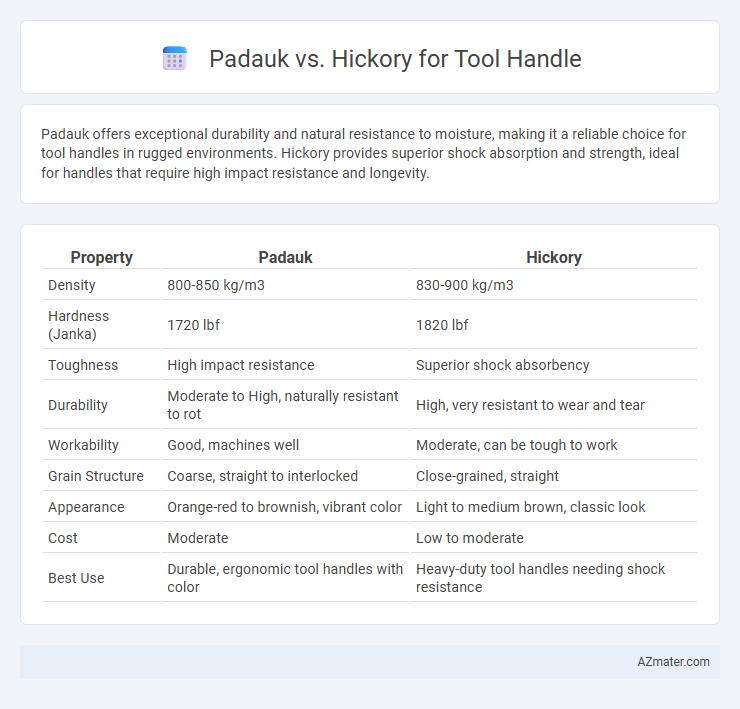Padauk offers exceptional durability and natural resistance to moisture, making it a reliable choice for tool handles in rugged environments. Hickory provides superior shock absorption and strength, ideal for handles that require high impact resistance and longevity.
Table of Comparison
| Property | Padauk | Hickory |
|---|---|---|
| Density | 800-850 kg/m3 | 830-900 kg/m3 |
| Hardness (Janka) | 1720 lbf | 1820 lbf |
| Toughness | High impact resistance | Superior shock absorbency |
| Durability | Moderate to High, naturally resistant to rot | High, very resistant to wear and tear |
| Workability | Good, machines well | Moderate, can be tough to work |
| Grain Structure | Coarse, straight to interlocked | Close-grained, straight |
| Appearance | Orange-red to brownish, vibrant color | Light to medium brown, classic look |
| Cost | Moderate | Low to moderate |
| Best Use | Durable, ergonomic tool handles with color | Heavy-duty tool handles needing shock resistance |
Introduction to Padauk and Hickory as Tool Handle Woods
Padauk and Hickory are both popular hardwood choices for tool handles, known for their durability and strength. Padauk is a dense, reddish-orange wood prized for its resistance to wear, shock absorption, and natural oils that enhance grip and prevent moisture damage. Hickory, native to North America, is celebrated for its exceptional toughness, impact resistance, and flexibility, making it a traditional favorite for heavy-duty tool handles such as axes and hammers.
Overview of Padauk: Characteristics and Properties
Padauk wood is highly valued for tool handles due to its dense, durable, and shock-resistant properties, making it ideal for withstanding heavy use. Its natural oils provide excellent resistance to moisture and decay, enhancing longevity in demanding environments. The vibrant reddish-orange hue and smooth grain also contribute to an ergonomic grip and aesthetic appeal in tool handle applications.
Overview of Hickory: Characteristics and Properties
Hickory is renowned for its exceptional strength, shock resistance, and durability, making it a preferred choice for tool handles that endure heavy impact. Its dense grain structure offers excellent stiffness and resilience, reducing vibrations and enhancing user comfort during prolonged use. The wood's natural toughness, combined with resistance to wear and abrasion, ensures tool handles crafted from hickory provide long-lasting performance in demanding applications.
Durability Comparison: Padauk vs Hickory
Padauk offers moderate durability with good resistance to wear and impact, making it a reliable choice for tool handles that require steady performance. Hickory outperforms Padauk in durability due to its superior shock resistance, high tensile strength, and excellent flexibility, which reduce handle breakage under heavy use. Overall, Hickory remains the preferred option for heavy-duty tool handles, while Padauk serves well in applications with lighter mechanical stress.
Strength and Shock Resistance Analysis
Padauk offers moderate strength with a Janka hardness around 1,290 lbs, providing decent durability for tool handles. Hickory, boasting a higher Janka hardness of approximately 1,820 lbs, excels in strength and is renowned for exceptional shock resistance, making it the preferred choice for high-impact tools. The dense grain structure of hickory absorbs vibrations efficiently, reducing user fatigue compared to the slightly less resilient padauk wood.
Workability and Ease of Shaping
Padauk offers excellent workability for tool handles due to its moderate density and straight grain, making it easier to shape and sand smoothly. Hickory, while tougher and denser, provides superior shock resistance but can be more challenging to carve and requires sharper tools for precise shaping. Both woods offer durability, but Padauk is preferred when ease of shaping and a smooth finish are priorities.
Weight and Balance Considerations
Padauk offers a moderate weight with a density around 850 kg/m3, providing a balanced feel without excessive heaviness, making it suitable for tool handles requiring maneuverability. Hickory, known for its exceptional strength and approximately 760 kg/m3 density, is slightly lighter but delivers superior shock resistance and durability, ideal for heavy-use tools. Both woods provide excellent balance, but Padauk's heft favors precision control while Hickory's resilience supports endurance in demanding applications.
Resistance to Moisture and Environmental Factors
Padauk offers excellent resistance to moisture and environmental factors, making it highly suitable for tool handles exposed to varying weather conditions. Its natural oils and dense grain provide superior durability against rot, decay, and insect damage compared to Hickory. Hickory, while strong and impact-resistant, is more prone to swelling and moisture absorption, which can compromise its longevity in damp environments.
Aesthetic Appeal: Grain, Color, and Finish
Padauk features a vibrant reddish-orange hue that deepens to a rich purplish-brown with age, offering a striking, exotic appearance ideal for tool handles seeking bold aesthetics. Hickory presents a lighter, creamy to reddish-brown color with a more subdued and classic grain pattern, prized for its traditional and rustic appeal. Both woods take finishes well, but Padauk's dense grain produces a smoother, glossy surface while Hickory's open grain provides a textured, natural look that enhances grip and visual character.
Cost-Effectiveness and Availability
Padauk offers a cost-effective alternative to Hickory for tool handles due to its relatively lower price and easier availability in global hardwood markets. Hickory, prized for its exceptional toughness and shock resistance, tends to be more expensive and can be less readily sourced outside North America. Choosing Padauk can reduce material costs while still providing satisfactory durability for most tool handle applications.

Infographic: Padauk vs Hickory for Tool Handle
 azmater.com
azmater.com